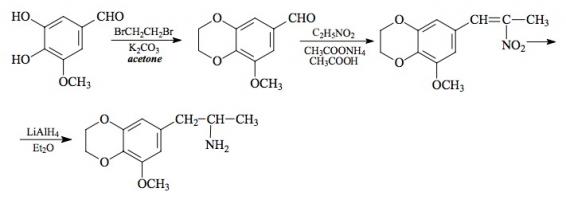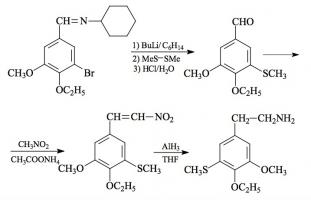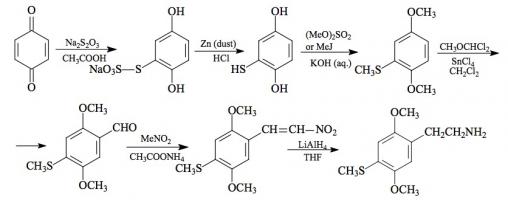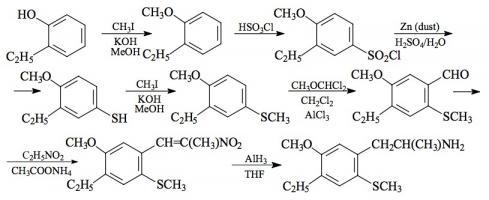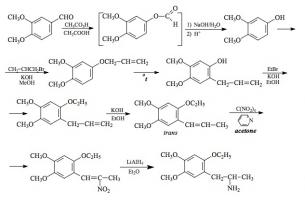PiHKAL: The Chemical Story 5

#56 DMCPA; 2-(2,5-DIMETHOXY-4-METHYLPHENYL)CYCLOPROPYLAMINE

SYNTHESIS: To a solution of 25 g 2,5-dimethoxy-4-methylbenzaldehyde (see the recipe for 2C-D for the preparation) and 29.2 g malonic acid in 50 mL anhydrous pyridine, there was added 2 mL piperidine and this was heated on the steam bath for several h. The mixture was added to a solution of 125 mL concentrated HCl in 500 mL H2O at 0 °C, and the solid product that was formed was removed by filtration, and washed with H2O. Recrystallization from aqueous EtOH yielded 31 g 2,5-dimethoxy-4-methylcinnamic acid with a mp of 163-166 °C. Anal. (C12H14O4) C,H.
In a cooled high-pressure reaction vessel there was placed a suspension of 30 g 2,5-dimethoxy-4-methylcinnamic acid in 150 mL liquid isobutene. This was treated dropwise with 0.6 mL concentrated H2SO4, then sealed and brought to room temperature. After 48 h shaking, the vessel was cooled again to -10 °C, opened, and poured into 200 mL of 10% Na2CO3. This was extracted with hexane, the pooled extracts washed with H2O, and the solvent removed to yield 17.0 g of (t)-butyl 2,5-dimethoxy-4-methylcinnamate as an amber oil. Anal. (C16H22O4) C,H.
The cyclopropane ester was prepared by the reaction between 16 g (t)-butyl 2,5-dimethoxy-4-methylcinnamate and dimethylsulfoxonium methylide, prepared as described in the Kaiser reference in the acknowledgements. Hydrolysis of this ester gave 53% trans-2-(2,5-dimethoxy-4-methylphenyl)cyclopropanecarboxylic acid which, after recrystallization from a MeOH/H2O mixture, had a mp of 136 °C. Anal. (C13H16O4) C,H.
A suspension of 4 g of trans-2-(2,5-dimethoxy-4-methylphenyl)cyclopropanecarboxylic acid in an equal volume of H2O, was treated with sufficient acetone to effect complete solution. This was cooled to 0 °C and there was added, first, 2.0 g triethylamine in 35 mL acetone, followed by the slow addition of 2.5 g ethyl chloroformate in 10 mL acetone. This was stirred for 0.5 h, and then there was added a solution of 1.7 g NaN3 in 6 mL H2O, dropwise. After 1 h stirring at 0 °C, the mixture was quenched by pouring into H2O at 0 °C. The separated oil was extracted with Et2O, and extracts dried with anhydrous MgSO4. Removal of the solvent under vacuum gave a residue of the azide, which was dissolved in 10 mL anhydrous toluene. This solution was heated on the steam bath until the nitrogen evolution was complete, and the removal of the solvent under vacuum gave a residue of crude isocyanate as an amber oil. This intermediate isocyanate was dissolved in 5.4 g benzyl alcohol and the reaction mixture was heated on the steam bath for 6 h. The excess benzyl alcohol was removed by distillation, yielding trans-2-(2,5-dimethoxy-4-methylphenyl)carbobenzoxyamidocyclopropane as a crystalline residue. This was recrystallized from an EtOAc/hexane mixture to give 6.13 g of a crystalline product with a mp of 107-108 °C. Anal. (C20H23NO4) C,H,N.
A solution of 1.5 g trans-2-(2,5-dimethoxy-4-methylphenyl)carbobenzoxyamidocyclopropane in 120 mL MeOH containing 200 mg 10% Pd/C was shaken under hydrogen gas at 35 psig for 45 min. The solution was filtered through celite, and a sufficient amount of a solution of 5% HCl in EtOH was added to the filtrate to make it acidic. Removal of all volatiles under vacuum gave a solid residue that was recrystallized from an EtOH/ether mixture to give 0.98 g of trans-2-(2,5-dimethoxy-4-methylphenyl)cyclopropylamine hydrochloride (DMCPA) as white crystals with a mp of 210-211 °C.
DOSAGE: 15 - 20 mg.
DURATION: 4 - 8 h.
QUALITATIVE COMMENTS: (with 10 mg) The effects were quite real at an hour, but very hard to define. Nothing left at four hours, but my sleep was filled with bizarre and colorful dreams. Something was still working somewhere, at some level.
(with 20 mg) I found myself lightheaded, and the thinness seemed to be, rather remarkably, on the left side of my brain. The experience was flighty. I was reminded of the aura that has been described preceding a convulsion. I was decoupled from my experience and from my environment. Not all of the control is there, and I am uncomfortable. But in an hour, there is complete control again, and I can relax my conscious guard which allows an easy plus three. With this, there was easy fantasy, erotic, quite a bit of movement in the visual field, and mild anorexia. The residual hyperreflexive thinness is largely gone, and not at all worrisome. This stuff is complicated, with a little too much of the physical. The next day was without any residues at all.
EXTENSIONS AND COMMENTARY: Most of the human trials took place in the fifteen to twenty milligram range. Several reports describe some muscular tremor, especially in the earliest part of the experience, but this never seemed to be a concern. The efforts to lock imagery to music were not too successful. All of these clinical studies were conducted on the trans-compound, but on the racemic mixture. This has been resolved into the two optical isomers, but they have not been compared in man. The cis-mixture is unknown.
This material is intimately related to tranylcypromine, a clinically proven antidepressant. This drug is a known monoamine oxidase inhibitor, and it is certainly possible that some of this pharmacological property might be found in DMCPA if it were to be looked for. The hints of physical toxicity at the higher doses assayed might suggest some such activity.
This compound, DMCPA, was modeled directly after the structure of DOM, with the 2,5-dimethoxy-4-methyl substitution pattern. Another analogue of tranylcypromine, similarly modeled, is 3,4,5-trimethoxytranylcypromine, or trans-2-(3,4,5-trimethoxyphenyl)cyclopropylamine (TMT). It has been evaluated at levels of only 13 milligrams orally, and at this dose there were no hints of central activity.
#57 DME; 3,4-DIMETHOXY-'-HYDROXYPHENETHYLAMINE

SYNTHESIS: To a solution of 10.2 g 3,4-dimethoxybenzaldehyde in 10 mL EtOH, cooled to 0 °C, there was added a solution of 4.2 g KCN in 40 mL H2O. With good stirring, there was slowly added 10 mL concentrated HCl (caution: HCN is evolved) and the two-phase reaction mixture was allowed to continue stirring until there was the spontaneous formation of crystals. After a few days standing, these were removed by filtration and well washed with H2O. All was recrystallized from 75 mL of 50% MeOH and air dried to provide 6.95 g of the cyanohydrin 3,4-dimethoxy-a-hydroxyphenylacetonitrile. The mp was 104-106 °C, which can be increased to 109 °C by recrystallization from benzene.
A well-stirred suspension of 4.7 g LAH in 500 mL anhydrous Et2O was brought up to a gentle reflux, and 4.7 g 3,4-dimethoxy-a-hydroxyphenylacetonitrile was leached in from a Soxhlet thimble, over the course of 3 h. The color of the ether solution progressed from yellow to green, to an eventual blue. The reflux was maintained for 16 h. After cooling again, there was added (carefully) a solution of 27 g H2SO4 in 500 mL H2O. The completely clear two-phase mixture was separated, and the aqueous phase treated with 87 g potassium sodium tartrate. The addition of 25% NaOH brought the pH >9, and this phase was extracted with 4x100 mL CH2Cl2. Removal of all the organic solvents under vacuum gave a residue that was part oil and part solid. This was extracted with 4x50 mL boiling Et2O, the extracts pooled, and saturated with anhydrous HCl gas. The 0.95 g of pale-yellow crystals that formed were removed by filtration, and finely ground under 5 mL CH3CN. There remained, after refiltration and air drying, 0.85 g of 3,4-dimethoxy-'-hydroxyphenethylamine hydrochloride, DME, with a mp of 170-172 °C.
DOSAGE: greater than 115 mg.
DURATION: unknown.
QUALITATIVE COMMENTS: (with 115 mg) I was faintly nauseous about an hour after taking the compound, and perhaps I was more alert than usual in the evening. Substantially no effects.
EXTENSIONS AND COMMENTARY: The rationale for exploring the beta-hydroxylated phenethylamines, especially those with oxygens at the biologically important 3- and 4-positions, has already been presented. Norepinephrine is a '-hydroxylated phenethylamine with oxygens at these two ring positions. With DME, these are masked as two methyl ethers, and the initials DME stand for 3,4-dimethoxyphenyl-'-ethanolamine. This is an alternate name for 3,4-dimethoxy-'-hydroxyphenethylamine.
An exactly analogous compound is 3,4-methylenedioxy-'-ethanolamine, where the masking is done with the biologically more fragile methylenedioxy ether. Originally I had called this compound MDE (methylenedioxyethanolamine) but that code has been, since 1975, used exclusively for 3,4-methylenedioxy-N-ethylamphetamine, which is a recipe all by itself. Under the discussion of members of the BOX series, there is a methylenedioxyphenethylamine with a methoxyl group at the '-position, and it is called BOH (q.v.). There, a reasonable code name for this specific compound is given, namely BOHH. "BO" stands for the beta-oxygen function on a phenethylamine; this is the heart of the BOX family. The "H" which is the third letter of BOHH stands for the free hydroxyl group. And the final "H" is for homopiperonylamine (which is the trivial name for the compound without the hydroxyl group). BOHH, or 3,4-methylenedioxy-'-hydroxyphenethylamine, or 3,4-methylenedioxy-'-ethanolamine, has also be assayed in man at up to 100 milligrams without any effects, and must be considered, as of now, to be inactive centrally. The possible toxic roles of '-ethanolamines as potential adrenolytic agents, have been discussed in the BOHD recipe. And beware of the use of the code name MDE in the very old literature. It might be this BOHH compound.
#58 DMMDA; 2,5-DIMETHOXY-3,4-METHYLENEDIOXYAMPHETAMINE

SYNTHESIS: Apiole, as the crystalline essential oil 1-allyl-2,5-dimethoxy-3,4-methylenedioxybenzene, is isolated directly from commercial Oil of Parsley, by careful fractional distillation. It is the fraction that boils at 165-167 °C at 27 mm/Hg. A solution of 19.8 g apiole in a mixture of 43 g KOH and 60 mL hot EtOH was heated in the steam bath for 24 h. With vigorous stirring, it was diluted with H2O, at a rate which the crystals that formed spontaneously could accumulate from the turbidity that was generated. When no more H2O could be added (there was persistent oiling out of material) the reaction mixture was filtered to give 12.1 g of an amber solid material. This was recrystallized from 20 mL boiling hexane, which was filtered while hot to remove insolubles. From the cooled filtrate, there was obtained 9.3 g of 2,5-dimethoxy-3,4-methylenedioxy-1-propenylbenzene, isoapiole, as pale cream-colored solids.
A stirred solution of 8.8 g 2,5-dimethoxy-3,4-methylenedioxy-1-propenylbenzene and 3.9 g pyridine in 45 mL acetone was cooled to ice-bath temperatures, and treated with 7.9 g tetranitromethane. This extremely dark reac-tion was stirred at 0 °C for 5 min, then quenched with a solution of 2.6 g KOH in 45 mL H2O. With continued stirring, there appeared yellow crystals of 1-(2,5-dimethoxy-3,4-methylenedioxyphenyl)-2-nitropropene which, after filtering, washing with 50% acetone and air drying, weighed 8.0 g and had a mp of 110-111 °C.
To a well-stirred and gently refluxing suspension of 6.3 g LAH in 500 mL anhydrous Et2O, under an inert atmosphere, there was added 7.5 g 1-(2,5-dimethoxy-3,4-methylenedioxyphenyl)-2-nitropropene by leaching out the nitrostyrene from a thimble in a modified Soxhlet condenser apparatus. The addition took 1.5 h, and the refluxing was maintained for an additional 3 h. After cooling, the excess hydride was destroyed by the cautious addition of 300 mL of 1.5 N H2SO4. The aqueous phase was brought to a pH of 6 with Na2CO3. This was heated to 80 °C and clarified by filtration though paper. The addition of a stochiometric amount of picric acid in boiling EtOH gave rise to precipitation of the product picrate as globs that did not crystallize. These were washed with cold H2O, then dissolved in 30 mL 5% NaOH. Extraction with 2x75 mL Et2O, and the stripping of the solvent from the pooled extracts, gave 3.1 g of an oily residue which, upon dissolving in 250 mL Et2O and saturation with anhydrous HCl gas, gave white crystals. These were removed by filtration, Et2O-washed, and air dried, to give 2.9 g of 2,5-dimethoxy-3,4-methylenedioxyamphetamine hydrochloride (DMMDA) that melted in the 165-175 °C range.
DOSAGE: 30 - 75 mg.
DURATION: 6 - 8 h.
QUALITATIVE COMMENTS: (with 25 mg) The intoxication was there at an hour and a quarter, and I was hit with nausea with no particular warning. I am shaky, a little dilated in the eyes, and there is a modest depersonalization (reminding me of LSD). Time might be slightly slowed, and there is a mild ataxia in the legs. A couple of hours later, all effects are going away fast. I ate an apple, but maybe my mouth didn't work quite right. The apple was incredibly noisy.
(with 32 mg) I am up to a 2 1/2 plus at something after two hours, with no apparent visuals, no push, no erotic. And a few hours later it is quietly slipping away. It felt completely safe, and without any conspicuous psychedelic action, at least at this level.
(with 50 mg) I took graded doses of 10 milligrams every thirty minutes for a total of 50 milligrams, and there were no effects at all.
(with 50 mg) In the middle of this all, I found myself getting into abstract thinking, and maybe some imagery as well. The effects were disappointingly light.
(with 75 mg) This was equal to somewhere between 75 and 100 micrograms of LSD. I was caught up with the imagery, and there was an overriding religious aspect to the day. The experience had an esthetic value. I liked it.
EXTENSIONS AND COMMENTARY: DMMDA was the first of the tetraoxygenated amphetamine derivatives that was ever explored in man, back in 1962. And it is not easy to find an acceptable single phrase to describe its action or an acceptable number to describe its potency. I have put the value of 10 mescaline units (M.U.) into the literature and this would imply that maybe 30 milligrams was an active dose. This is probably too low, and some day I would like to run an experiment with the entire research group with this compound to see just what it really does.
The essential oil that corresponds to DMMDA is, of course, apiole from the Oil of Parsley, which again ties together the spice world and the amphetamine world. And there is isoapiole, also a natural thing. This pair represents the ring-substitution pattern of one of the ten essential oils and DMMDA is one of the ten essential amphetamines.
Several people have asked me what I thought about the potential activity of a compound with a methyl group added to DMMDA. One of these possibilities would be the N-methylated derivative, 2,5-dimethoxy-N-methyl-3,4-methylenedioxyamphetamine, or METHYL-DMMDA (or DMMDMA for the dimethoxy-methylenedioxy-methamphetamine nomenclature). It is a MDMA analogue, and is described in the recipe for METHYL-MMDA-2.
The placement of an added methyl group onto the '-position of DMMDA, rather than on the nitrogen atom, produces a pair of stereoisomeric homologues. These are the threo- (or-trans-) and erythro- (or cis)-2,5-dimethoxy-'-methyl-3,4-methylenedioxyamphetamines. They have never been assigned trivial names (my original codes for them were S-1495 and S-1496 which is not too intuitively informative). Their chemically proper names would have the 2-amino-3-substituted phenylbutane form. The synthesis of these DMMDA homologues started with the reduction of the nitrosyrene to the ketone (see under METHYL-MMDA-2 for this preparation), followed by methylation with fresh sodium isopropoxide and methyl iodide, to give the beta-methyl product. This formed the two possible oximes, one with a mp of 120 °C, and the other from MeOH with a mp of 146 °C. The 120 °C oxime, with fresh sodium ethoxide gave threo-2-amino-3-(2,5-dimethoxy-3,4-methylenedioxyphenyl)butane hydrochloride. This salt had a mp of 247-249 °C. The 146 °C oxime gave erythro-2-amino-3-(2,5-dimethoxy-3,4-methylenedioxyphenyl)butane hydrochloride with a mp of 188-189 °C. The threo-isomer showed a possible threshold effect at 80 milligrams, with hyperventilation and perhaps some mental muddiness. The erythro-isomer showed no effects, but it had been taken up only to 10 milligrams.
The only other '-methyl homologue of an active material that was explored chemically, was related to MDA. The ketone (3,4-piperonylacetone, see under MDMA) was methylated with sodium isopropoxide and methyl iodide, and a crystalline oxime was obtained. Reduction with Zn dust gave what appeared to be 2-amino-3-(3,4-methylenedioxyphenyl)butane hydrochloride, but there were sufficient uncertainties (possible dimethylation, only one oxime isolated, the need of strong reducing conditions) that the entire project was placed in, and still is in, an indefinite holding pattern. The similar analogues for DOM are the two Classic Ladies, DAPHNE and ELVIRA, and they, too, are for some time in the future.
#59 DMMDA-2; 2,3-DIMETHOXY-4,5-METHYLENEDIOXYAMPHETAMINE

DOSAGE: about 50 mg.
DURATION: unknown.
QUALITATIVE COMMENTS: (with 50 mg) I am into it; it is much like MDA.
EXTENSIONS AND COMMENTARY: This is pretty sparse information upon which to build a picture of biological activity. First, the synthesis was done by someone else and, as I have not been able to find where the notes are, this will be the one recipe in the footnote without explicit directions incorporated. The procedure used was exactly the same as that described for DMMDA, except that the starting material was dillapiole rather than apiole. The dillapiole was obtained by the careful fractionation of Oil of Dill (as opposed to the isolation of apiole from the careful fractionation of Oil of Parsley). Isomerization to isodillapiole, nitration with tetra-nitromethane to give 1-(2,3-dimethoxy-4,5-methylenedioxyphenyl)-2-nitropropene, and its reduction with LAH in ether to give 2,3-dimethoxy-4,5-methylenedioxyamphetamine hydrochloride (DMMDA-2) proceeded in a precisely analogous manner to the preparation of DMMDA.
And the pharmacological part is rather thin as well. I was not the taster, and can only quote what I had been given. This same observer found a threshold at 28 milligrams. Under other circumstances, this comment on DMMDA-2 would have been tucked into the commentary on DMMDA where it belongs, but the activity level was called for in a large review article, and on the basis of the above, both its initials and the value of 5x the potency of mescaline were permanently enshrined in the published literature. What is it really like? I don't know. Its structure is an appealing amalgamation of that of MMDA and MMDA-2, and it might be quite a winner if the dosage and the duration were known. It is, after all, one of the ten essential amphetamines, since dillapiole is one of the ten essential oils.
At the time that DMMDA and DMMDA-2 were synthesized, I had visions of doing the same thorough study with these as I had set up with the TMA's (six possible, six done) and the MMDA's (six possible, five done). Here, too, with a pair of methoxy groups on an amphetamine skeleton, with a methylenedioxy ring thrown in, six isomers are possible but only these two have been prepared. The unknown ones will certainly be called DMMDA-3, -4, -5 and -6, but the assignments of code to structure haven't even been thought out yet. The remarkable and totally unexpected activity of DOM was discovered at about this time and it was a much more tempting direction to follow. The remaining four possible DMMDA's have been left to that famous time, a future Rrainy day.











